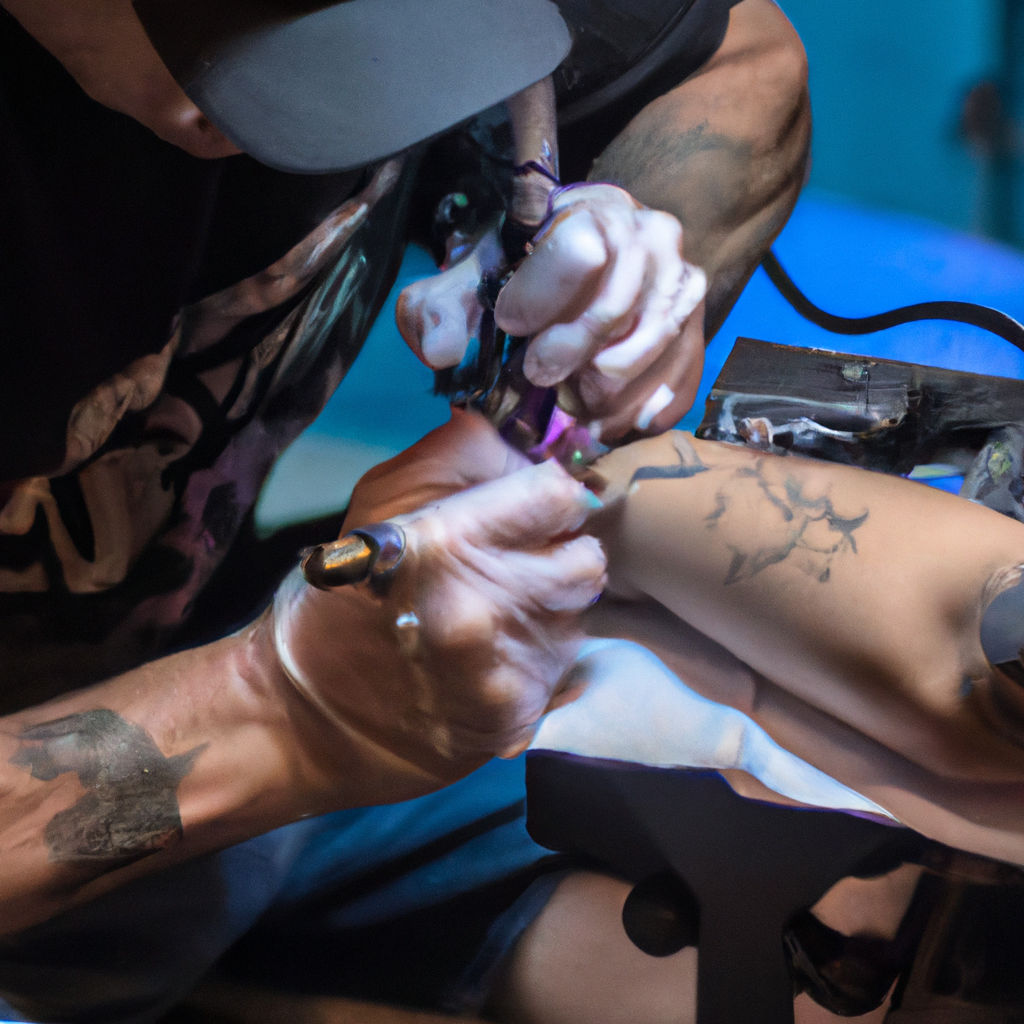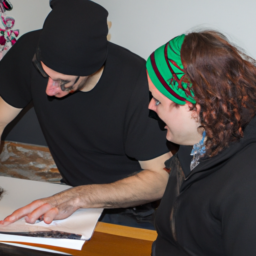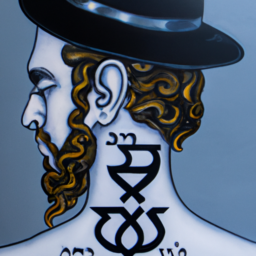“The Art of Choosing the Right Hebrew Script for Your Tattoo”
Tattoos in foreign languages, particularly Hebrew, have gained popularity over the years, becoming a new trend in the world of body art. More and more people are opting for Hebrew script tattoos due to their unique aesthetic appeal and deep-rooted spiritual significance. However, choosing the right Hebrew script for your tattoo is of utmost importance as each script is loaded with meaning and conveys a powerful message.
Understanding the Meaning and Significance of Hebrew Language
The Hebrew language carries inherent depth and spirituality in its essence. Each individual letter and word is not merely a symbol or sound but conveys profound spiritual meanings. An understanding of these nuances can give your tattoo a unique and powerful representation.
For instance, each letter in the Hebrew alphabet is attributed with a numeric value, known as Gematria, which contributes to the mystical interpretation of the language. Moreover, the language is filled with terms and phrases that are rich in spiritual ideologies, religious history, and cultural elements.
Therefore, to script a Hebrew tattoo that resonates with its true meaning can be a transformative experience. It becomes not just a form of self-expression but also a symbol of your connection with broader spiritual thoughts or even the celebration of a particular cultural heritage.
However, understanding the deeper meanings of Hebrew words and scripts is not a simple task due to its intricate nature. Hence it’s important to deepen your understanding of the language and its various scripts before choosing one for a tattoo.
Whether you choose a quote from the Torah, a biblical saying, or simply a single word like “love” or “strength”, make sure you know the precise translation and interpretation. This ensures your tattoo remains true to its intended meaning and doesn’t end up as a regret or a source of embarrassment.
In conclusion, while choosing a Hebrew script for a tattoo, bear in mind the importance of accurate script selection that matches its intended meaning. This understanding not only raises your tattoo from being just a body adornment but elevates it to a statement of belief, spirituality, and cultural appreciation.
Remember, a tattoo is permanent – as should be the thought, understanding, and respect reflected in your choice of a Hebrew script.
Deciphering Hebrew Scripts for Tattoos
Choosing the right script for your Hebrew tattoo is an integral step in the process. Hebrew scripts, just like the language itself, are imbued with spiritual and historic implications. The most common ones include Modern, Traditional, and Biblical Hebrew scripts, each having its unique characteristics and contexts.
Applying Different Hebrew Scripts
Modern Hebrew script is often the go-to choice for most people, as it is currently used in Israel and globally. This script is characterized by its simplicity and lightness. If you seek to express something current, societal, or modern-like, this is the script to consider for your tattoo.
The Traditional or Mishnaic Hebrew script, used during the period 70–200 CE, carries a slightly archaic undertone and is less prevalent in contemporary life. However, it could be just the aesthetic you are searching for, especially if you want to exhibit a special affiliation with the ancient tradition of the Jews.
On the other hand, the Biblical or Paleo-Hebrew script is the oldest, dating back to the period 10th–3rd centuries BCE. This script could add a layer of historicity and sacredness to your intended design.
Guidance from Hebrew Specialists
It is vital to get expert advice when deciding on a Hebrew script tattoo. Consulting with Hebrew speakers or scholars can not only ensure accurate transcription but also provide an in-depth interpretation of the words or phrases you intend to ink.
Potential Risks without Expert Consultation
Hebrew is a language steeped in a rich history and spiritual depth. Each letter and word carries particular symbolic weight or significance. Hence, neglecting professional consultation and going forward based solely on literal translations could lead to serious misinterpretations and misrepresentations. This can result in a permanent mark on your body that doesn’t say what you intended it to mean – a mistake that you would definitely want to avoid.
Securing expert advice beforehand can also offer insights into the appropriate context to apply each script, the right font style to use, and the correct directionality and orientation of the Hebrew text on your body. Remember, it’s not just a tattoo; it’s a statement of your understanding and respect for the Hebrew language and lineage.

Contextualizing Your Hebrew Tattoo
Understanding the cultural context of your Hebrew tattoo is an essential process when choosing the right script. Hebrew, as a language, holds deep historical, cultural, and religious significance for many people worldwide. Consequently, the concepts, words, and symbols you choose can convey a strong message beyond their literal translation. It’s crucial to approach this process with sensitivity and respect to ensure your tattoo does not unintentionally offend or misrepresent the culture.
For example, certain phrases or symbols that possess profound religious undertones should be approached with caution. The Hebrew word for ‘life’, ‘chai’, is considered sacred and used judiciously within the community. Similarly, the Star of David is an important symbol that bears the weight of history and should not be used lightly.
The Importance of Choosing the Right Hebrew Script Tattoo
It’s not enough to select a Hebrew script tattoo that simply ‘looks cool’. It’s essential to consider the impact of these symbols and phrases within their cultural context. By doing this, you can ensure your tattoo communicates what you intend it to, without causing offense or misinterpretation.
Consider the example of the Shema Yisrael prayer. This central Jewish prayer, often considered the most essential declaration of faith in Judaism, is a profound spiritual statement. Therefore, non-Jews should be very cautious about tattooing this symbol as it could potentially be perceived as a cultural appropriation.
The best approach to picking a respectful and culturally appropriate Hebrew tattoo is to do plenty of research, consult with knowledgeable people, and consider the cultural implications of your chosen design. In doing this, your Hebrew script tattoo can serve as a deep, personal expression of your ideas or beliefs rather than a mistaken or superficial representation. SEO, popularity, culture, symbolism, and respect should always be at the forefront of your decision-making process when getting a Hebrew tattoo.
The Right and Wrong Way to Wear a Hebrew Tattoo
When deciding on a Hebrew tattoo, it’s critical to understand important aspects of the language, notably its directionality and orientation. Hebrew is read from right to left. As such, a Hebrew tattoo should follow the accurate directionality, preserving authentic form and readability. A common pitfall many fall into is inverting the script, leaving readers to decipher a backwards message due to neglecting this crucial fact.
Moreover, Hebrew letters and phrases often carry spiritual or religious connotations. Therefore, it’s necessary to comprehend the context and implications of your chosen design fully. One should avoid using the name of God in vain, a significant cultural taboo in the Jewish tradition. Furthermore, certain phrases and individual symbols carry deep historical baggage or significant undertones that might not align with the intended personal meaning.
Finally, tattoo placement of Hebrew script should be considered carefully. The body part on which the tattoo will be displayed may influence its interpretation or reception. Consulting with Hebrew scholars or native speakers can yield cultural insight into optimal and respectful placements.
You must be considerate of these factors not only to respect the cultural and linguistic heritage of Hebrew but also to ensure your tattoo represents accurately your intended message.
Famous Hebrew Tattoo Fails and Successes
It’s helpful to examine case studies of famous personalities who have successfully or unsuccessfully incorporated Hebrew tattoos into their body art. For instance, footballer David Beckham and singer Victoria Beckham accentuated their relationship with matching Hebrew tattoos of a verse from the Song of Solomon, demonstrating solid research behind their choice.
Conversely, British popstar Cheryl Cole faced criticism for a misspelt Hebrew tattoo. Cole’s tattoo, intended to say ‘new beginnings’, was misspelt due to a minor typographical error resulting in a different and unintended message. This example underlines the necessity for caution, extensive research, and consultation with experts.
Zoe Kravitz, an American actress, also opted for Hebrew ink but without any errors. Her tattoo, which says ‘Let love rule’, is correctly transcribed, making it a perfect example of attention to script, meaning, and cultural significance.
These famous instances underscore the importance of doing due diligence before permanently etching foreign scripts on one’s body, especially one steeped in profound spiritual and linguistic history like Hebrew.

Consulting Certified Translators for Your Hebrew Tattoo
In your journey towards embracing the rich heritage of Hebrew through script tattoos, it’s crucial to ensure the accuracy of your chosen script. This is where the indispensable role of engaging a certified translator comes in. Indeed, a vetted and qualified translator will do more than just a literal conversion of words; they will significantly guide you towards capturing the correct cultural nuances, comprehensive meanings, and semantic implications of your chosen Hebrew script.
Often, individuals tend to rely on online translation apps like Google Translate to convert their desired phrases into Hebrew. This approach is not recommended as it frequently results in inaccurate translations, leading to tattoo fails. These automated translations may lack the important cultural aspect associated with the script, thereby potentially insulting the sacred language and its heritage.
Locating a Certified Translator
But, where does one find a certified translator? These linguistics experts can be found through translation agencies, universities that offer courses in Semitic languages, or online platforms that connect clients with transcribers around the world. Before hiring, it’s generally recommended to ask for their qualifications and experience in translating Hebrew script tattoos.
A qualified translator understands the expressive depth of the Hebrew language and has extensive knowledge about the cultural intricacies, helping you avoid any embarrassments or misrepresentations. They will accurately translate your chosen phrase, ensuring it holds the exact intended meaning, given the context you wish to portray. By meticulously following this approach, you will respect not only the rich cultural heritage of Hebrew, but also cherish your tattoo as a correct tribute to it.
Remember, a Hebrew tattoo is not just a body art design; it signifies the enduring spirit, powerful legacy, and sacred scripture of a deep-rooted civilization.

In conclusion, choosing to ink a Hebrew script tattoo is not a decision to be made lightly. It requires a deep understanding of the nuances of the Hebrew language and the spiritual, linguistic, and cultural significance it holds. The wise route to take is not just selecting visually stunning Hebrew letters or phrases but understanding their inherent symbolism and meaning.
As with any language, Hebrew has its unique characteristics that require meticulous thought in their transcription. Misinterpretation can lead to embarrassing mistakes, as demonstrated by various famous personalities and their Hebrew tattoo faux pas. These instances underline the importance of precise translation to ensure that your tattoo correctly reflects its intention and doesn’t become an object of ridicule.
In this regard, consultation with Hebrew speakers, scholars, or certified translators is invaluable. Simple reliance on online translation platforms can lead to mistakes and distortions. Thus, investing time to find certified translators for authentic verification can safeguard you against any “Google Translate” pitfalls.
Understanding the different Hebrew scripts, their appropriate contexts, and the various font styles also shapes the correct representation of your intended message. Equally important is the consideration of cultural norms and respect towards the Hebrew language, avoiding any offensive depiction in your tattoo.
Moreover, the right orientation and directionality of Hebrew letters and phrases cannot be neglected. It is crucial to remember that the Hebrew language reads from right to left, a key aspect to incorporate in your tattoo’s design.
In the journey of adorning ourselves with the sublime beauty of Hebrew script tattoos, it is our responsibility to honor the rich heritage of the language, ensuring our tattoos truly encapsulate the profound meanings we wish to carry on our bodies. A miscalculation in the translation or interpretation doesn’t just risk inaccuracy, but can also inadvertently disrespect a language steeped in spiritual and cultural weight.
Hebrew tattoos serve as a bridge, merging ancient wisdom with modern expression. Therefore, it is pivotal to ink them with diligence, precision, and utmost respect.

